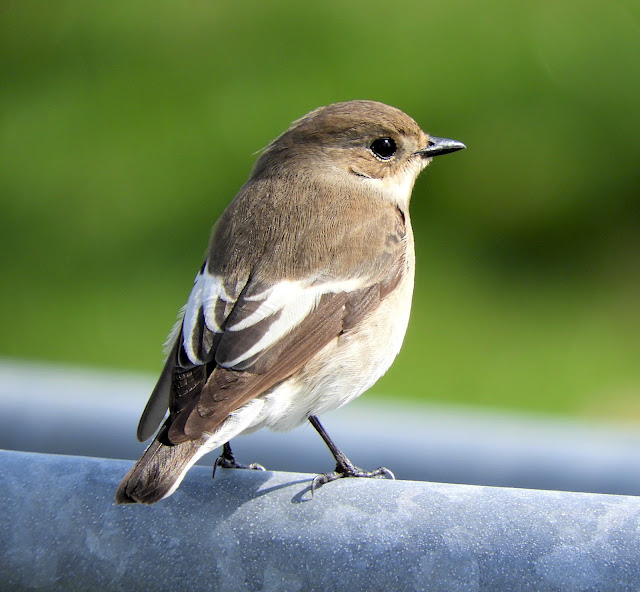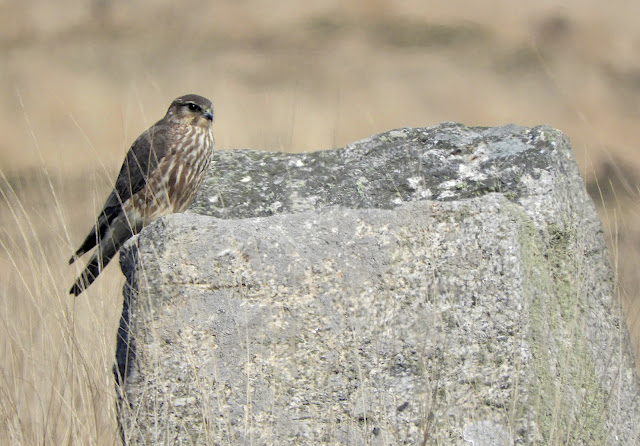An absolutely stunning summer-like day with wall-to-wall sunshine, clear skies, seabird-covered cliffs and next to no wind. Come 17:00 however, an eerie thick sea-mist rolled in on a chilly easterly breeze which lasted through the night.
A very quiet day migrant-wise with a mass exodus of yesterday’s birds and a lack of new arrivals.
Migrants logged on a day of seabird surveys included a Cuckoo – the second of the spring – ‘singing’ outside Paradise Row at first light, a lone Whimbrel in the Landing Bay, a female Redstart on the Terrace, a White Wagtail in Brick Field, seven Willow Warbler, seven Blackcap, two Goldcrest, a single Song Thrush, a handful of Wheatear along the main track and single-figure counts of Swallow (which included some of our Lundy breeding birds), Sand Martin and House Martin.
Non-avian sightings included three Barrel Jellyfish offshore along the east coast.
25th April
The thick sea-mist and fog remained from the previous evening for most of the morning, but brightening up by the afternoon, with very low winds throughout.
Another very quiet day for migrants, highlights being a flock of 11 Jackdaw in lower Aerogenerator (Lighthouse) Field and a female Merlin hunting Meadow Pipits in Brick Field in the afternoon.
Other migrants logged during another day of seabird surveys included a lone Whimbrel, just three Willow Warbler, two Chiffchaff, six Blackcap, a single Sedge Warbler, one Goldcrest, eight Swallow and small number of Wheatear pushing through.
 |
| Auk-covered ledges in Jenny's Cove, 25 Apr © Dean Jones |
 |
| Over 110 burrows had Puffins taking nesting material down them in Jenny's Cove, 25 Apr © Dean Jones |
26th April
Beautifully clear and still first thing, becoming overcast by the late morning, with the wind picking up from the west around 14:00, bringing with it some more clear skies.
A very quiet first few hours of the morning – and then as if someone flicked the migrant switch, a steady stream of birds started to arrive from the south come 08:00.
Highlights were the first Common Sandpiper of the year, scuttling along the low shore in the Devil’s Kitchen, as well as an amazing diversity of migrants throughout, including a total of seven Whimbrel, a lone female Sparrowhawk, the Jackdaw gang again in the Helicopter (Tent) Field, 149 Swallow, 112 Sand Martin, 21 House Martin, two Swift over the Village, a fly-over Tree Pipit, nine White Wagtails (which included a flock of seven in Brick Field), a male Yellow Wagtail in Barton Field, a male and female Redstart, a single Spotted Flycatcher above the Gas Shed, 19 Sedge Warbler, 57 Willow Warbler, 39 Blackcap, 14 Whitethroat, two Garden Warbler, three Chiffchaff, a single Lesser Whitethroat, one Goldcrest (a ringed female which has been present on the island since 18th Apr) and a small number of migrant Wheatear and Linnet.
 |
| Common Sandpipe, Devil's Kitchen, 26 Apr © Dean Jones |
 |
| Female Redstart, Terrace, 26 Apr © Dean Jones |
Among 57 birds ringed were (retraps shown in brackets): 19 Willow Warbler, 3 Chiffchaff, 12 Blackcap, 13 Sedge Warbler, 3 Whitethroat, 1 Garden Warbler, 1 Lesser Whitethroat, (1) Goldcrest, 1 Redstart, 1 Blackbird and 1 Goldfinch.
 |
| One of 13 Sedge Warblers ringed, 26 Apr © Dean Jones |
 |
| Lesser Whitethroat, Millcombe, 26 Apr © Dean Jones |
Non-avian sightings included at least 15 male Emperor Moths on the wing between Quarter and Halfway Walls.
27th April
A morning of thick sea-mist again, which burnt off by 08:00, with sunshine for the rest of the morning but becoming overcast in the afternoon; next to no wind throughout.
 |
| The much-loved MS Oldenburg arrives back from dry dock with lots of goodies (especially chocolate!) for the islanders, 27 Apr © DeanJones |
Another eventful day of migrants with two Wood Warbler – the first of the spring – taking the title of star birds!
 |
| Above and below: Wood Warbler, Lower East Side Path, 27 Apr © Dean Jones |
Other birds of note included three Whimbrel, the Jackdaw gang again on the roof of Old House South first thing, a Cuckoo at Halfway Wall being ferociously mobbed by Meadow Pipits, a male Kestrel, five Woodpigeon, 83 Swallow, 68 Sand Martin, 19 House Martin, three Swift, 29 Willow Warbler, two Chiffchaff, 19 Blackcap, two Whitethroat, nine Sedge Warbler, two Reed Warbler, a Lesser Whitethroat, a single Goldcrest, three Spotted Flycatcher, two Yellow Wagtail, two White Wagtail, three Stonechat and a small push of Wheatear and Linnet.
 |
| Cuckoo, Halfway Wall, 27 Apr © Dean Jones |
Twenty-one birds were ringed: 5 Sedge Warbler, 2 Reed Warbler, 9 Willow Warbler, 1 Chiffchaff, 3 Blackcap and a Wren.
Non-avian news included 14 male Emperor Moths on the wing, the first Green Tiger Beetle of the year (Rosie Ellis) and a Barrel Jellyfish in Threequarter Wall Bay.
Lundy is currently closed to visitors. The latest Covid-19 update from the Landmark Trust can be found here.









































